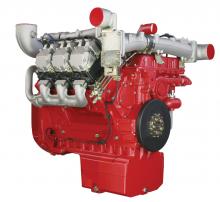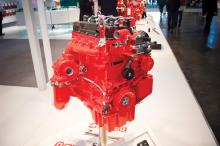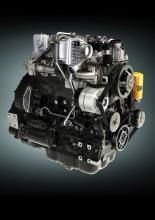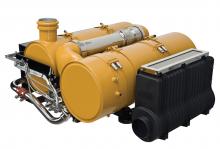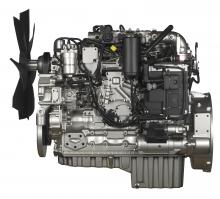Engine manufacturers have had to jump through regulatory hoops in recent years, meeting requirements for diesels with ever cleaner exhaust emissions. When this programme was first proposed, many believed the final aims could not be achieved. However on January 1st 2011, the Tier 4 Interim/Stage IIIB emissions regulations will come into force in North America and Europe and all the major diesel manufacturers will have suitable products at the ready. The Tier 4 Interim/Stage IIIB emissions regulations require

Liebherr's engine technology is being developed in partnership with MAN
Engine manufacturers are ready to meet the tough deadlines to reduce emissions - writes Mike Woof
Engine manufacturers have had to jump through regulatory hoops in recent years, meeting requirements for diesels with ever cleaner exhaust emissions. When this programme was first proposed, many believed the final aims could not be achieved. However on January 1st 2011, the Tier 4 Interim/Stage IIIB emissions regulations will come into force in North America and Europe and all the major diesel manufacturers will have suitable products at the ready. The Tier 4 Interim/Stage IIIB emissions regulations require a 90% reduction in particulate matter (PM) and a 50% reduction in nitrogen oxide (NOx) from previous Tier 3/Stage IIIA requirements. Building from these engines, the manufacturers will be well on track to achieve the even more stringent Tier 4 Final/Stage IV requirements set for 2014. As it stands most of the large engine firms already know the various technology packages that they will integrate to provide a solution and deliver the low emissions profiles of the Tier 4 Final/Stage IV requirements and the companies are at present testing and fine tuning their prototypes. Understandably all the major engine firms are keen to highlight that they are well on track and have solutions in hand.Getting to the current situation has not been easy. It has required a massive investment by all the manufacturers but the result will be beneficial, with high performance engines that are cleaner, quieter and more fuel efficient than ever before. Very different routes have been taken by each manufacturer to achieve the necessary low emissions performance. Even where companies have worked together, their approach and results have been markedly different and it is clear that there is no one single golden bullet that can provide all the necessary parameters as a single solution. Reaching the low emissions targets involves selecting from an array of differing solutions and developing these in a manner appropriate to what may also be widely different off-highway machine duty cycles and applications.
There have been partnerships though, between companies, sometimes between rivals.
Fuel does present a major issue for the new generation of low emission engines though. Because the emission control technology is so complex, many believe it will be impractical to 'deTier' the sophisticated low emission engines at some point in the future, which would allow them to be sold in countries where low sulphur fuels are not available. This means that secondhand machines built to meet market demands in North America or Europe could not be subsequently sold into developing countries. The trade in good quality secondhand machines to developing countries will only be able to continue if supplies of high quality, low sulphur fuels can be guaranteed. Without low sulphur fuel, tests have shown that the life of a Tier 4 Interim/Stage IIIB engine will be very short indeed. Corrosion of the intricate fuel delivery system is a major problem when using high sulphur fuels in the Tier 4 Interim/Stage IIIB emission compliant engines, although other serious technical issues also occur. Similarly, the Tier 4 Interim/Stage IIIB technology is too complex and too deeply integrated into an engine to be available as a retrofit package for existing engines. However diesel particulate filtration (DPF) systems will be available as a retrofit option for earlier generation engines.
The sophistication of the high pressure, computer controlled, fuel injection systems plays a key role in all low emission engines. Caterpillar says it is now machining parts to the micron level and the firm is not alone in this respect. At Caterpillar, a massive test programme is being used to evaluate its Tier 4 Interim/Stage IIIB engines. This is being carried out in simulated work environments, with repeated tests over several hundreds of hours on engines placed under load. The engines are continuously monitored using a massive bank instrumentation to evaluate factors such as temperatures and pressures of oil and cooling systems and turbos, as well as power output, torque rise and acceleration profiles. At the same time the firm is also carrying out dynamic tests, to ensure that the low emissions equipment will also be able to cope with the rigors of working on-site.
Caterpillar now has the Tier 4 Interim/Stage IIIB certification for its C9.3 ACERT diesel engine. The new C9.3 engine is said to deliver high fuel efficiency and productivity and is the first Caterpillar off-road engine to receive emissions certification in the 130-560kW category.
Tana Utley, Caterpillar vice president and chief technology officer said that the engines have been purpose-designed to meet the needs of the market and have been developed with the benefit of considerable customer input. Caterpillar's ACERT (advanced Caterpillar emission reduction technology) uses a modular approach to reducing emissions and is based the integration of key systems. The C9.3 ACERT engine will be used in a wide variety of applications. By the time Tier 4 Interim/Stage IIIB products reach customers, Caterpillar's validation programme will have accumulated nearly one million hours of operation, the most thorough programme of this type in the firm's history.
Meanwhile Cummins has upgraded its version of the four cylinder QSB3.3 and QSB4.5 engines as well as the all-new QSX11.9 and QSX15 Heavy Duty engines, which meet the Tier 4 interim/Stage IIIB emissions and noise regulations. All four engines come with after-treatment systems to suit off-highway installations. The QSB3.3 and QSB4.5 engines are aimed at the 56-119kW power output range and have the same external dimensions as the existing Tier 3 units, while the new QSX engines offer power outputs from 224-447kW. Over 20,000 operating hours have been logged with the test engines in an array of installations, the biggest field trial Cummins has ever carried out. Cummins has fitted new air filters and exhausts to the QSB engines, which feature exhaust gas recirculation (EGR) systems as well as particulate after-treatment technology, variable flow turbochargers and compact air cleaners. The two larger QSX units feature the firm's innovative XPI fuel system technology, developed in partnership with Scania. This injection system is complemented by variable geometry turbochargers that match engine speed and load, as well as integrated sensors to measure temperature and pressure and allow optimum airflow. Both the updated QSB and new QSX engines are said to offer gains in fuel efficiency of 5% on average, across a range of duties and installations and there are also cooling modifications for these EGR-equipped diesels.
Deutz is offering an array of new engines and is addressing the 28-86kW output range with its TCD2.9, TCD3.6L4, TCD4.1L4 and TCD6.1L6 diesels. The new TCD2.9 engine suits power outputs from 28-55.9kW
and its low emissions performance is achieved using the firm's innovative Dvert system, a package of technologies for exhaust after-treatment that can be matched to the customer's requirements. The TCD2.9 is a 2.9litre, four-cylinder diesel and because this engine is under the 56kW threshold it only requires a diesel oxidation catalyst, which is compact, maintenance free, inexpensive and quick to install. Much of the in-cylinder technology is also seen on the larger engines from the firm and the TCD3.6L4 is a four-cylinder that is offered with or without charge air intercooling and cooled exhaust gas recirculation. The engine features a high-pressure common rail fuel system that operates at 1,600bars, which further helps it achieve its low emissions performance. The new TCD4.1L4 has power outputs from 70-115kW, while the six-cylinder TCD6.1L6 is rated at 120-180kW. The TCD6.1L6 uses high-pressure fuel injection rated at up to 1,600bars for outputs up to 160kW and up to 2,000bars when delivering outputs up to 180kW.
The new JCB Ecomax T4 4.4litre engine is now undergoing in-field testing and the firm has opted to achieve the Tier 4 Interim/Stage IIIB requirements without using DPF. According to
To achieve the emissions regulations, JCB Power Systems worked closely with research and development specialist Ricardo, using computational fluid dynamics, finite element analysis and a Ricardo-designed combustion bowl to perfect the combustion process. Using second generation common rail fuel injection technology, injection pressures have been raised to 2,000bars and nozzle hole geometry has been refined to provide highly effective atomisation and distribution of the fuel within the cylinder. JCB is using variable geometry turbochargers while cooled EGR is also used to clean up the exhaust gases before they are passed from the engine. The company has worked with fuel system and electronics specialist
Perkins Engines now has the 1200 Series engines to meet the Tier 4 Interim/Stage IIIB requirements. These offer power ratings of 60-225kW, starting with the 4.4litre 1204 and rising to the 7litre 1206 engines. The most powerful variants come with two turbochargers, one small and one larger, to provide improved response and high torque at low engine speeds. Both of the 1206 models use a diesel oxidation catalyst (DOC) as well as a DPF to ensure emissions regulations compliance. The smaller engines are turbocharged and intercooled, while the higher power versions also uses twin turbochargers. All 1200 Series engines now use Perkins' NOx Reduction System (NRS) which is said to cut fuel use and emissions.
Scania has based its emission compliant, off highway engines on its road haulage truck range. The new off-highway engines use high pressure common-rail fuel injection, increased combustion pressures, wastegate turbochargers and selective catalytic reduction (SCR) exhaust after treatment. Selective catalytic reduction (SCR) is a means of converting nitrogen oxides, also referred to as NOx with the aid of a catalyst into diatomic nitrogen, N2, and water, H2O. Scania's fuel injection system (developed with Cummins), works at pressures of up to 2,400bar, providing high torque outputs at low revs and increased engine output. Engines will be available in 9.3litre five cylinder, 12.7litre six cylinder and 16.4litre V8 variants, to suit a wide range of machinery.
With its new generation V-ACT (Volvo-Advanced Combustion Technology) engines
The new engines will also feature ultra high pressure variable fuel injection systems, precise control of the turbochargers, powerful new engine management systems (EMS) and an integrated exhaust after-treatment system that features a particulate filter and thermal regenerator. Variable geometry turbocharging and DPF are also important factors in the new emissions system. To ensure the DPF equipment retains its performance, this is able to re-generate itself by monitoring parameters and burning out particulates at periodic intervals, typically every 8-10 working hours. The regeneration process takes around 20 minutes and during this time the machine is still able to deliver full power, while the DPF system will have a working life of at least 4,500 working hours. The company has an exchange programme for the DPF systems, which helps address issues of cost for the customer. The company has already delivered the first of its Tier 4 Interim/Stage IIIB machines to site and these are being evaluated with a series of key customers, which involves extensive performance monitoring.

